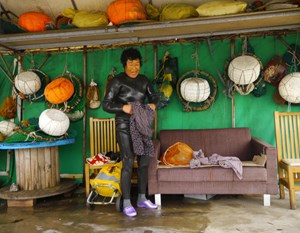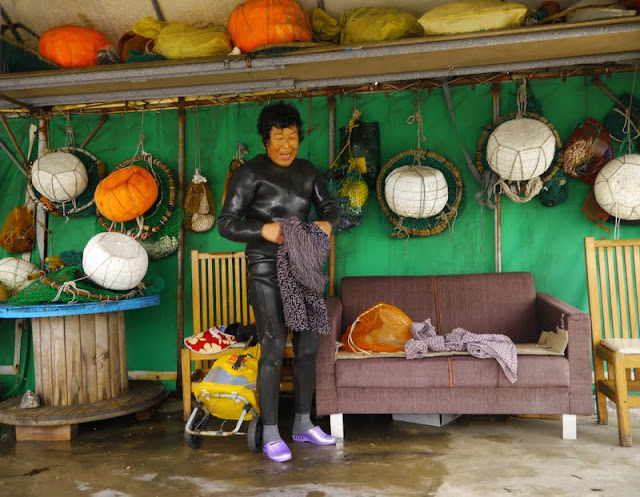
Jeju is a blackened island off the coast of Korea, an exotic upsurge of volcanic rock which in 2007 was named a World Heritage Site, thanks to its mysterious geology. It was here Greek/British artist Mikhail Karikis first heard the cry of the haenyeo. “I heard a very high-pitched sound coming from the sea. At first I thought it was a bird call or maybe seals,” he tells me via phone. “I asked my friend to stop the car and I saw a pod of black figures in the water.”
Jeju is a blackened island off the coast of Korea, an exotic upsurge of volcanic rock which in 2007 was named a World Heritage Site, thanks to its mysterious geology. It was here Greek/British artist Mikhail Karikis first heard the cry of the haenyeo.
“I heard a very high-pitched sound coming from the sea. At first I thought it was a bird call or maybe seals,” he tells me via phone. “I asked my friend to stop the car and I saw a pod of black figures in the water.”
These were not creatures of East Asian mythology, but a community of aging female divers, all in their 70s and 80s (haenyeo translates as sea-women). With a keen professional interest in sound, Karikis was shocked to find this “half-human, half-animal” call came from these unlikely sirens.
He was full of questions, but the artist soon discovered that the other-worldly sound was linked to an ancient breathing technique called sumbisori which enabled the women to remain under water, fishing and collecting pearls, without breathing apparatus, for extended periods of time.
At first, Karikis struggled to understand why the divers were all women. This has to do with female fat distribution, which is favourable to cold water diving. But there have been other reasons, including a sexist tax break under a Confucian law which failed to recognise female labour.

© Mikhail Karikis
In the 1970s, the sea-women represented the dominant economic power on the island. Now large-scale fish and pearl farming, together with warming oceans, have made this into a dying art. The daughters of the sea-women are typically university graduates with jobs in tourism.
To the metropolitan westerner, it remains strange to see an elderly woman catch an octopus in open water. “They go really deep onto the bottom of the sea to catch them,” says Karikis, who dives with the women in his film. Seaweed and sea cucumber are also on the menu.

© Mikhail Karikis
Another occupation of the women is ‘cleaning’ the sea. This can be a job for the oldest women, who will dive from coastal rocks rather than boats. Karikis met one 87-year old whose work was weeding out starfish and other creatures that inhibit the populations of desirable shellfish.
“Everything is hand picked,” explains Karikis, “So the bottom of the sea is never destroyed. It’s quite sustainable”.
It’s for reasons like this that the sea-women are celebrated by feminists and greens alike. Their ancient community runs along matriarchal lines and the artist has even heard reports that they physically intimidate the male inhabitants of Jeju.
Male westerner Karikis, for one, was sensitive to cultural differences with the women. “That first encounter is always a little bit awkward,” says the filmmaker, “So I never present my camera. I'm very careful about rituals of politeness and hierarchy that especially in Korea are quite strict.”

© Mikhail Karikis
The artist persisted, making his overtures to the sea-women with the help of younger Korean friends who spoke the Jeju dialect, plus a feminist group. The feminists, who were all in their forties, “really revere this group of haenyeo, because they've become a symbol of ecological feminism and women’s independence and self sufficiency”.
But despite the formal introductions, his intrusive presence became the source of light relief when he took his first dive. He tells me how, inadvertently, he broke the ice: “They lent me one of the wetsuits they wear, and they found it so funny that on the following day they took cameras to take photos of me!”
The subsequent film has been shown several times on Korean television. “It was on a mainstream news channel,” Karikis tells me; an estimated three million people tuned in. He has also shown the work in a Korean museum. “It was amazing. They have been really accepting,” he reports.

© Mikhail Karikis
Despite his extraordinary access to an ancient culture, Karikis got little closer to the mystery of the animal sound which first piqued his interest. “I met some people at the Univeristy in Jeju, and they just explained to me why they think they do it, and what the role of the sound might be.”
So there remains an unknowable kernel to the breathing technique, and the resulting sound of the sea-women. “There isn't really any proven physiological reason for it,” the artist continues. “We don't really know why they make the sound exactly.”
Visitors to Brighton Earsthetic Festival will be able to savour the strangeness of the haenyeo with a two channel film on giant facing screens and a 4.1 surround sound installation. The siren song will echo throughout its concert hall venue.
This is a film installation in which sound comes first. “I will usually form a concept or have a series of questions about a specific sound and then I compose the visuals around that,” Karikis explains.

© Mikhail Karikis
But thanks to the remarkable geographical location, the visuals in this case will compete for your attention. A preview makes Jeju look like the ends of the earth.
“The horizon of the ocean is something epic or sublime, something greater than us,” says Karikis, “and I think it's that combination of natural elements and extraordinary sound that that made it feel very magical”. Who can resist the sea-women’s lure?
SeaWomen by Mikhail Karikis is part of Earsthetic Festival 2015. It can be seen at Brighton Dome between November 25 and December 1 2015. You can see more work by the artist in British Art Show 8, which can be seen in Leeds until January 10, before it tours to Edinburgh, Norwich and Southampton in 2016.

ArtDependence Magazine is an international magazine covering all spheres of contemporary art, as well as modern and classical art.
ArtDependence features the latest art news, highlighting interviews with today’s most influential artists, galleries, curators, collectors, fair directors and individuals at the axis of the arts.
The magazine also covers series of articles and reviews on critical art events, new publications and other foremost happenings in the art world.
If you would like to submit events or editorial content to ArtDependence Magazine, please feel free to reach the magazine via the contact page.